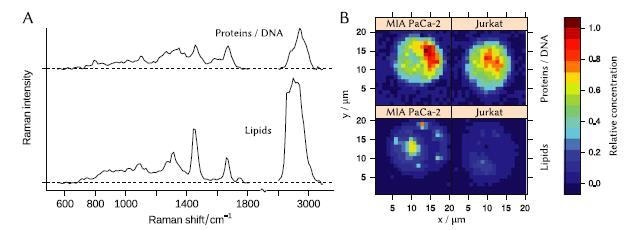Jun 7 2016
Raman spectroscopy has the ability to provide detailed chemical information. It also holds the potential to analyze biological samples non-destructively in combination with a microscope.
 (A) - N-FINDR end-members that represent spectra of lipid and protein/DNA mixture. (B) - concentration maps of the end-members in cells of Jurkat and MIA PaCa-2 cell lines. (CREDIT: Biomedical Spectroscopy and Imaging)
(A) - N-FINDR end-members that represent spectra of lipid and protein/DNA mixture. (B) - concentration maps of the end-members in cells of Jurkat and MIA PaCa-2 cell lines. (CREDIT: Biomedical Spectroscopy and Imaging)
The commercially available research-grade Raman microscopes not only seem to be very costly but are also inflexible.
A recent study conducted by scientists from Germany and Serbia has described a versatile micro-Raman system that can be built using the readily available components at a lesser cost when compared to a commercial tool. This study results has been reported in Biomedical Spectroscopy and Imaging.
Micro-Raman spectroscopy is particularly suitable for biological research as it integrates chemical characterization with label-free imaging. It has the ability to detect the differences in biomolecular composition, and can relate the obtained results with the related biological changes that occur due to pathology or metabolism and many In living cells, Raman spectroscopy holds potential for rapid clinical diagnosis and in many other applications like studies of drug uptake or drug resistance, observation of cell metabolism, aging, and growth, chemical mapping of cells, etc. As diseases are developed at the cellular level, this ability will help in understanding the cellular changes that lead to development of diseases.
Over 20 components, including a motorized table, cameras, filters, mirrors etc, were procured by the authors to construct this microscope. According to the authors, about €10,000 would be required to build this microscope and does not demand skilled expertise in optical assembly.
The ability to switch the microscope from an upright to an inverted configuration makes it flexible, providing an important parameter for analyzing biological samples. The microscope is specifically effective in hyperspectral imaging, with the help of which determination of chemical composition of each pixel in a scanned image is made possible. Besides Raman spectroscopy, the microscope system can also be integrated with other modalities like fluorescence imaging.
Raman maps of separate cells from two different cancer cell lines MIA PaCs-2 pancreatic cancer and Jurkat, T-Lymphocytes were collected using the microscope. With the help of the spectra that was collected from each point, a relative concentration of lipids against DNA and proteins were mapped .
As per the lead investigator Prof. Jürgen Popp, PhD, of the Leibniz Institute of Photonic Technology and the Institute of Physical Chemistry and Abbe Center of Photonics, University Jena (Germany), the development of this instrument embodies their institute’s mission, “From ideas to instruments.”
We acquired Raman images of single human cells with a custom instrument. These data demonstrated that the instrument provides spectra of sufficient quality to distinguish the cell type. This result will be exploited in projects about identification of tumor cells circulating in blood.
Researcher Christoph Krafft, PhD
Together with Besides Prof. Popp and Dr. Krafft coauthors Iwan W. Schie and Roman Kiselev, from the Leibniz Institute, and Sonja Aškrabić, of the Institute of Physics, University of Belgrade, Belgrade, Serbia, Prof. Popp and Dr. Krafft feel that any user who is interested can develop a similar cheap and flexible tool to perform crucial and potentially revolutionary research.
The advances made by the authors will make Raman micro-spectroscopic imaging of biological systems accessible to a greater number of scientists, especially those who do not have sufficient funding to purchase the more expensive instruments. Thanks to this development we are likely to see a growth in Raman micro-spectroscopic imaging of biological samples including cancer tissues.
Biomedical Spectroscopy and Imaging Editor-in-Chief Dr. Parvez I. Haris, Faculty of Health & Life Sciences, De Montfort University, UK